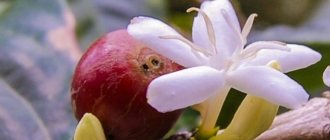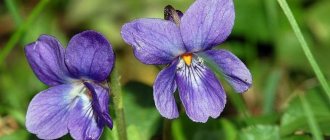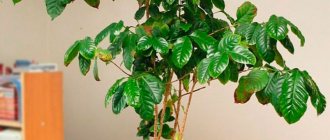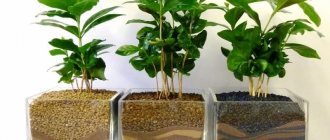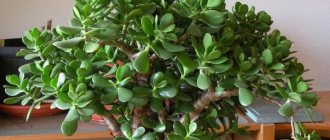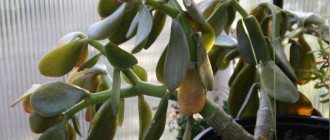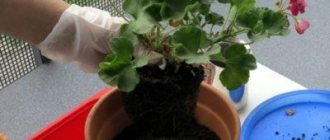Indoor trees are very popular in modern decorative floristry. Compared to regular flowers, they require significantly less care. At the same time, a small tree looks impressive in almost any room.
Dear readers! For you, we have created communities on social networks in which useful articles and interesting ideas are published several times a day! Subscribe and receive useful content in a convenient format!
In today's article we will talk about one of the most popular indoor woody plants, the coffee tree.
Botanical description and homeland of the plant
The plant is part of the Rubiaceae family. The tree's homeland is ancient Abyssinia (modern Ethiopia). Now the coffee tree can be found even in the wild in South America, Asia, and other areas of Africa.
Indoor varieties are widespread everywhere.
At home, coffee is a low bushy tree that grows mainly in several thin trunks. The plant does not branch much. The process of formation of additional shoots usually begins only in the 2nd year. Coffee has large oval leaves with a pointed tip. The surface of the leaf blade is slightly convex with clearly visible veins. The color is green.
Coffee blossoms and bears fruit. The inflorescence is umbellate and consists of small white flowers. After flowering, a fruit is formed, which turns red when ripe. The berry is covered with a small crust, inside there is sweet and sour pulp and a couple of seeds-grains, from which the famous drink is prepared.
A little about coffee trees
The coffee tree is a plant up to 5-8 meters, but in everyday life its height can be easily controlled by regular pruning - usually up to 2 meters. The leaves are dark green, slightly ribbed, shiny and beautiful. In its subtropical conditions, Arabica flowers bloom twice a year, and many achieve the same at home. In cold climates it can bloom in spring and summer.
Small white flowers are similar to jasmine, with a rather bright aroma; flowering begins at about 2-3 years. Then the fruits appear, at first they are green, eventually turning red. You don’t have to take them off right away, you won’t miss a moment - they can remain on the branches for 2 months without deteriorating, only slightly drying out.
The optimal temperature is from +10 to +25 degrees, possibly from +5 to +30. But frequent temperature fluctuations can cause leaves to drop.
Caring for your coffee tree after purchase
Before you go to the store and buy yourself a new green pet, you should think about where to put it. Remember that coffee is a tree, and although it will not grow to several meters at home, it still needs space.
So, you bought yourself a coffee seedling. First of all, he must be quarantined. This is necessary so that the plant gets used to the new conditions. Also during this time you can find out whether the plant is sick and whether pests live on it.
In addition to quarantine, the coffee tree can be replanted. A transplant is required in the following cases:
- Several coffee cuttings sit in one container;
- The pot is too low quality;
- The soil mixture is a nutrient substrate, not ordinary soil.
ON A NOTE. Don't worry if all the leaves have fallen off the tree after replanting. This is due to the fact that all the plants in stores are “overfed”. Very soon the coffee will return to normal.
Soil preparation
You can only grow coffee at home in suitable soil. The optimal composition is perlite and peat.
A mixture of river sand, ground peat and leaf turf in proportions of 2:2:1 is also suitable. Or an equal amount of humus, leaf turf, sand, black soil and two parts of acidic peat.
Mix the ingredients in the required proportions and pour into a small container.
Do not compact the soil too hard. It must be loose so that air gets to the root system.
Add finely chopped sphagnum moss. It retains moisture and maintains soil acidity.
Be sure to install drainage at the bottom of the pot. When loose soil is watered, the water moisturizes the roots well and does not stagnate. The excess will drain into the pan, so the roots will not rot if there is excessive moisture.
Before planting the cuttings, the soil is disinfected with a weak solution of potassium permanganate.
Growing conditions
In general, the coffee tree does not pose impossible tasks for the grower. The plant needs quite ordinary care and growing conditions, but with its own characteristics.
Temperature
Coffee loves warmth, but does not handle heat very well. The ideal temperature is 23 – 25 degrees. In winter, you can slightly reduce the temperature, but only to 15 degrees. If the temperature drops further, the coffee may shed its leaves.
IMPORTANT! Protect the tree from sudden changes in ambient temperature and drafts. Both have a negative effect on flowering and fruiting.
Air humidity
Coffee prefers high air humidity. In a dry climate, the tree does not feel well, often gets sick, and blooms poorly.
Additionally, it is recommended to spray the plant with a spray bottle. In the summer, you can periodically “bathe” the coffee tree.
IMPORTANT! In winter, the tree tub should be placed away from radiators, as the tips of the leaves will begin to wither due to dry air.
Coffee also loves fresh air, so we recommend periodic ventilation in winter. The main thing is to make sure that there is no draft, as this can make the plant sick.
Coffee tree after spraying
Lighting
The coffee tree comes from Africa, which means it loves light. But it is still undesirable to expose it to direct sunlight. It would be ideal to shade the plant a little. To do this, you can cover the windows with paper, use tulle or Roman blinds.
ON A NOTE. If your apartment does not have the right place with sufficient lighting, then the coffee tree can be placed under fluorescent lamps.
The soil
For a coffee tree, it is better to choose acidic soil (with a pH level less than 7). If you prepare the soil yourself, then follow these proportions: 2 parts acidic peat, 1 part distilled, 1 part sand, 1 part each leaf and greenhouse soil.
Pot
It is equally important to choose the right pot. In a container that is too small, the plant will be cramped. The roots will quickly fill the entire volume, and the coffee will begin to hurt. If it is too large, on the contrary, the tree will not be able to receive all the nutrients when watering and feeding.
It follows from this that you need to choose a medium-sized pot for the plant, so that it is not cramped, but there is space to grow.
In what cases is support needed?
Sometimes your green pet may need support. These are mainly cases when the plant has too thin shoots, as well as after transplanting into a new pot, when the tree has not yet taken root.
Choosing a place to put it
Indoors, the coffee tree is best placed near a south window. If this is not possible, then place the tree on the east or west window.
It is not recommended to place the pot in dark corners or in the back of the room. Lack of lighting negatively affects the decorative qualities of the plant.
In late spring and summer, the coffee tub can be moved to the loggia or taken out to the terrace. The tree will really like this, as it will be provided with a sufficient amount of light and fresh air.
What does it look like in the interior?
The coffee tree is not just another flower in a pot. This is part of the interior decor of any room. The plant looks beautiful in a modern studio apartment, office, and bedroom. The coffee tree is also great for decorating public spaces: cafes, reception areas, corridors, conservatories, etc.
Coffee varieties
Arabica
The most common variety of coffee tree.
The plant is demanding to care for, needs diffused sunlight and moderate moisture.
In nature, the tree grows up to 10 meters. But for convenient collection of beans it is cut to 4 meters
Arabica does not tolerate cold. Therefore, the tree is grown at a temperature of at least 15 degrees Celsius.
The Arabica drink has a sour taste. The bean contains 1.5% caffeine.
Robusta
The Robusta coffee variety is unpretentious in terms of content. It grows at temperatures down to 0 degrees and tolerates heat well. Another advantage is resistance to pests.
Interesting! How to grow Arabic coffee in a room - characteristics of the plant, and methods
Up to 1.5 kg of beans are collected from one tree (0.9 kg from Arabica).
Robusta has a pronounced bitter taste. Therefore, grains of this variety are added to mixtures. Mono varieties are rare.
Robusta beans contain about 3% caffeine.
Liberica
Less popular variety due to low taste. Liberica is mainly used to make coffee blends and instant coffee. It is also used in the manufacture of confectionery products.
Of the total volume of coffee trees grown, only 2% is Liberica.
Trees do not do well in drought and high humidity. If there is prolonged bad weather, the tree stops bearing fruit.
This variety is resistant to diseases and insect pest attacks.
Liberica beans contain up to 2.4% caffeine and are three times longer than Arabica beans.
Excelsa
Excelsa is a type of liberica. It easily tolerates heat and high humidity, but is demanding on the composition of the soil. This variety needs moist soil with a rich organic composition.
The trees reach a height of 20 meters.
The brewed drink has a fruity smell and a chocolate-nut taste with hints of sourness. Excelsa is added to elite coffee varieties.
One bean contains up to 1.5% caffeine.
Flowering conditions
The coffee tree blooms in spring. It forms umbrella-shaped inflorescences consisting of small white flowers. At the same time, the tree emits a pleasant aroma.
REFERENCE. The coffee tree fades very quickly. Don't miss this amazing moment!
Flowering
You can also help the plant bloom. To do this, gently shake the branches on which the inflorescences appeared. Another way is to take a cotton swab or soft brush and touch the flowers. This will cause artificial pollination.
After flowering, fruits begin to set. They ripen almost throughout the spring-summer period, and in some cases the process can even take 1.5 – 2 years.
IMPORTANT! In order for coffee to bloom bright and memorable, it needs to be allowed to rest in winter. During the dormant period, you will have to reduce watering and eliminate the application of fertilizers. You also need to slightly reduce the temperature.
Watering and fertilizing
With proper care, your indoor Arabica coffee plant should be watered as the soil dries out. For this, only settled water is suitable, which does not contain lime impurities (they harm the roots). It is necessary to monitor the acidity level of the soil, for which it is recommended to add a few drops of table vinegar or citric acid to the already prepared water for irrigation.
It is recommended to apply fertilizers during the growth period (April-September) every 2-3 weeks. Liquid mineral mixtures that help stimulate the formation of young shoots are optimally suited for feeding. The nutritional elements they contain have a beneficial effect on the growth and development of the tree.
It is especially important to fertilize the coffee plant during the period of bud formation, when it needs additional amounts of phosphorus and nitrogen. Adding bone meal or horn shavings is suitable for this.
It is also recommended to use forest moss.
Transfer
While the coffee tree is young, it is replanted every year. Upon reaching the age of three, the growth of the tree slows down. Accordingly, the frequency of transfers is reduced. It will need to be carried out approximately once every four years.
Replanting a plant is no different from a similar process carried out with other indoor flowers. On the contrary, replanting a coffee tree is even easier, since it has stronger roots.
Saplings
ON A NOTE! But this does not mean that you need to work sloppy. Still, try not to damage the root system.
- First of all, prepare a pot of suitable size, proper soil and drainage.
- First, place the drainage in a new container.
- Then remove the plant from the old pot. This must be done using the transshipment method.
- If old drainage is stuck to the bottom, carefully shake it off.
- Carefully remove the old soil.
- If you want to plant the cuttings in different pots, then place the entire plant in a bowl of warm water and carefully wash off the remaining soil. Next, carefully separate the tangled roots of each stem.
- Sprinkle the drainage in the new pot with soil and place the seedling there.
- Carefully add soil to the desired level and water the transplanted plant.
IMPORTANT! If you are not replanting, then change the top layer of soil. This is necessary so that the earth does not become depleted.
How to choose and where to buy coffee seeds?
So, if you are planning to buy seeds for planting, you need to know a few nuances about the seed:
- Coffee seeds lose their viability very quickly.
Already a month after the grain was removed from the tree, its germination rate drops by 50%, another half a month and germination rate drops by 90%; - It is better to buy seeds from breeders and it is advisable that the grain is surrounded by pulp
. Only in this case can you guarantee good germination of the seed; - Germination of coffee tree seeds up to the formation of the first pair of true leaves should be carried out in conditions of high humidity. Otherwise, the dense shell of the grain on the sprout, which has just taken root, will not open and the cotyledons (the first pair of fake leaves) will be damaged. This will negatively affect the development of the plant;
- If you buy coffee seeds for planting in a store, their packaging date should not exceed 1.5 months
at the time of purchase of the seed. Only then can we hope for the germination of at least one grain.
Preparation for planting coffee seeds in pulp is very simple: the pulp is removed from the beans. The seeds themselves can be soaked in a growth stimulant or aloe juice, or you don’t have to do this, since such seed germinates well. The grains are immersed in the soil by 1.5-2 cm, watered and placed in a greenhouse. It is not recommended to use coffee beans from unripe berries (green berries) for planting coffee beans. They will not germinate, but will simply rot in the ground.
If you buy coffee seeds for planting at a regular flower shop, they will be dry and without pulp. The date of coffee harvesting and packaging is very rarely indicated on the bag of seed material. That is why you need to rely on the integrity of the seller, who will not slip expired goods. But even if the coffee tree seeds in the store are fresh, you need to perform the following manipulations with them before sowing.
So how do you prepare coffee seeds for planting? Preparation takes place in several stages
:
- remove the parchment shell
that surrounds the grain. Sclerification increases the percentage of grain germination. You can remove the parchment shell without damaging the grain if you soak the seed for 2 hours in warm water; - mandatory treatment with growth stimulants
. This could be Zykron, Epin or any other similar drug. Soak for at least 8 hours. If you don’t have growth stimulants on hand, you can use a solution of potassium permanganate (potassium permanganate). The solution is prepared with a pale color. Before sowing, coffee beans are also soaked for 8 hours in aloe juice; - To process and increase the percentage of germination of coffee beans, it is recommended to soak them in a solution of hydrogen peroxide. For the first 10 minutes, the concentration of the solution should be within 3%. After the above time, the concentration of hydrogen peroxide decreases to 1-0.5%. Coffee beans should remain in this solution for 24 hours before sowing.
High-quality coffee seeds suitable for planting, regardless of variety, will have a white or milky white hue. If the coffee beans are brown or green, they are either damaged by disease, very old, or moldy. They won't germinate.
The photo below shows an example of Arabica Nana coffee seeds.
Reproduction
Coffee is propagated by seeds or vegetatively. Below we will talk about each method in a little more detail.
Propagating a coffee tree from seeds
If you are an experienced gardener, you can try to grow a coffee tree from an ordinary coffee bean.
Fruit
REFERENCE. Roasted grains will not work.
First of all, it is necessary to destroy the “shell” on the grain. To do this, you can carefully file it or soak it in a solution of hydrochloric acid. We recommend making careful cuts, as the use of chemicals can damage the seed itself.
Next, the seeds are washed with potassium permanganate and placed in a solution of a growth stimulator. Any will do.
You need loose soil, consisting of turf soil, sand, ash and peat. The seeds are placed in the soil and pressed down slightly. Then the plantings are watered and covered with film, a transparent plastic lid or a plastic bag. This is how we create a greenhouse effect inside.
There is no need to place the pot directly in the sun, but it should not be placed in the shade either. A warm place near the windowsill is best.
The seeds will germinate in about a month.
The first transplant is carried out when foliage appears.
How to propagate vegetatively
The vegetative method is the most effective and requires much less labor.
- First of all, prepare the cuttings. They should be about 8 – 10 cm long and have at least 2 buds.
- Then place the cuttings in containers and keep them warm.
- To make rooting go better, put a plastic bag on top or cover it with a jar. This will create a greenhouse effect.
- Periodically water the soil and ventilate the seedlings.
- Once the plants have taken root, they should be transplanted into permanent pots.
Propagation by cuttings
How to grow a coffee tree at home
Growing a coffee tree from beans will be difficult, because this requires fresh, only collected seeds. The easiest way to propagate it is by stem cuttings from another tree. The cuttings must be straight, healthy, reach at least 15 centimeters in length and have at least a couple of leaves. It is better to cut it diagonally.
Soak the stem in a solution to stimulate growth for several hours, and then stick it into the prepared soil. For the soil, a sand-peat mixture with a mandatory drainage layer is best suited. The stem can be covered with a plastic bag dome to maintain proper humidity. Only the bag should not touch the leaves.
Keep the soil well moist and wait for new leaves to appear on the stem. This means that the plant has taken root and can be replanted.
Next, we’ll talk about how to organize the care of your coffee tree. Despite the fact that this is a tropical plant, it is not so demanding to care for.
Maintain the correct temperature and humidity
The coffee tree is most comfortable at 20–30 degrees in spring and summer. In winter, when the plant is resting, 15 degrees is enough.
Coffee grows in very humid climates, so it is important that the indoor humidity is above average, around 70%.
An easy way to provide the plant with the right moisture is to fill a shallow tray with pebbles and fill them with water until it just barely covers the stones. Place the pot on top, just so that the soil does not come into contact with the water. The water in the tray will gradually evaporate, creating a humid climate around the coffee.
It is also worth grouping moisture-loving plants with each other. Then they will collectively release moisture, creating an ideal microclimate for themselves.
In hot weather, the coffee bush should definitely be sprayed with soft, settled water from a spray bottle. This should not be done in winter. Unless there is a heating device nearby, which additionally dries the air.
Protect the plant from drafts - it can die even from momentary hypothermia. But you shouldn’t place a coffee tree near heating radiators either, otherwise it will dry out.
Do not constantly rearrange or rotate the plant pot. The coffee tree does not like changes in habitat and may begin to fade from frequent rearrangements. Ideally, immediately determine a sufficiently spacious place for it and keep it only there.
Do not place the coffee tree in direct sunlight
Coffee is moderately light-loving, but does not tolerate direct sunlight. Therefore, the pot with it can be placed on the north and west windows or next to them. One sign that a plant is getting too much sun is brown spots on the leaves. If you see them, move the pot to a darker place.
If a tree does not bloom for a long time and is always in the shade, it is worth moving it closer to the sun, at least temporarily.
Keep the soil moist but not soggy
The coffee tree loves humidity, but not excessive moisture. When water sits in the pan, it can already harm the plant. Plant coffee in well-draining soil that drains moisture well.
At first, regularly check the soil to determine which watering regime is suitable for your plant. If the leaves droop, the coffee should be watered immediately.
In winter, watering can be reduced to once a week, if the room humidity is good. Water the plant only if the top layer of soil is dry.
Water for watering a coffee tree must be well defended. It should be soft and warm, so if necessary, it’s even worth warming it up a little.
In spring and summer, coffee leaves should be sprayed regularly, almost daily, with water. This should not be done during cold seasons.
Feed the coffee tree with fertilizers
During the period of active growth, it is especially important to feed coffee with fertilizers. The feeding method is the same as for other indoor plants. In the spring, nitrogen fertilizers are applied, as well as one portion each of mineral and organic. In summer, only monosubstituted potassium phosphate is enough. And in the fall you can feed the crown with potassium salts by spraying. In addition, once every 1–2 months, acidify the soil with a solution of citric acid at the rate of 1 gram per liter of water.
If you follow the regime of fertilizing the coffee tree, it will grow well, delighting you with a lush green crown.
How to form a crown
The coffee tree itself is highly decorative. Its shoots are weakly branched, and large beautiful leaves form a beautiful crown. In general, coffee does not require decorative pruning.
However, it all depends on the specific instance. It is necessary to regularly trim dried shoots, and it is also a good idea to remove too long branches. The fact is that they will take away the energy that the plant needs to bloom. It is better to carry out the operation in late winter - early spring.
If you doubt whether your green pet needs pruning, then it is better not to do it.
Diseases, pests and problems in growing
Coffee trees are a favorite of pests. They often suffer from scale insects, mealybugs, and in dry air from spider mites. It will not be possible to cope with pests only by correcting conditions or washing them; coffee requires multiple treatments with insecticides.
Any violation in care is dangerous. Brown spots on leaves appear unpredictably and are not always explainable. When watered with regular, settled, or even more so, hard water, the tips of the coffee leaves turn black and necrosis spots develop due to the inability to absorb nutrients from non-acidic soil. Direct sun leaves severe burns on the leaves; coffee reacts to a lack of light by stopping growth. Dropping leaves is a signal of dampness. And leaf drying occurs not only in dry air, but also in the event of improper feeding.
For the coffee tree, the simplest and most productive method is cuttings.
Rejuvenation
Unfortunately, about 10 years after planting, coffee begins to age. The decorative value of the plant decreases. The leaves become yellowish and limp. So, it's time to rejuvenate.
To do this, cut the stems. The procedure must be carried out with a sharp instrument so that the cuts are neat and even. Do not break the shoots under any circumstances! Even if the tree survives, it will finally lose its decorative effect and become ugly.
Don't forget to treat the cut areas with crushed activated carbon.
ON A NOTE. By the way, cuttings are taken from the cut branches for propagation.
Harvesting
By carefully caring for your tree, protecting it from pests and diseases, in 4-5.5 years you will be able to collect your first coffee harvest. Having noticed that flowers have appeared on the tree, it is recommended to have time to lather them. After all, their beauty is short-lived.
After 10 days, the flowers will be replaced by berries. They will ripen for about six months. Each of them contains only 2 coffee beans. The collection is done, just like the coffee beans are extracted, only by hand. Ripe berries, after being picked for about 30 days, are first dried in the sun, then they are dried in a dry black room for another month. Afterwards, you need to peel off the dried berry pulp and extract the coffee beans.
Growing a coffee tree at home is not difficult. But, like any plant, it requires attention and some care. With proper organization of its maintenance, you can become not only the owner of a lush, beautiful bush. Once collected, you will be able to prepare the most delicious coffee, grown on your home coffee plantation.
We hope that this article was useful to you, we would be grateful if you share it with your friends on social media. networks. Have a nice day and see you again!
Watering
Coffee is a water-drinker. In the spring-summer period, you need to water abundantly and often (every 2 - 3 days). But do not allow the soil in the pot to become waterlogged. Loosen the soil regularly to prevent it from clogging.
During the dormant period, watering should be reduced to once a week. In winter, simply do not allow the soil to dry out and maintain the general level of humidity.
For irrigation you need to use soft, settled water. If you have such an opportunity, water with rain or snow water. But do not forget that the liquid should be at least room temperature, and preferably a couple of degrees warmer. Cold water can cause shock to the roots, which can lead to all sorts of troubles.
Coffee tree at home signs. Coffee tree: signs
Hearing the word “coffee,” most people imagine a cup of aromatic, steaming drink, and only keen flower growers see in their imagination a tub with a spectacular plant covered with clusters of bright red-brown fruits. After all, it is impossible to grow a heat-loving tropical miracle in your yard, but decorating a room with it is very simple. The domestic coffee tree is an excellent choice for lovers of large “green pets”, as it is easy to care for and very decorative.
In addition, exotic has unique esoteric abilities that can affect health and lifestyle, bring good luck and prosperity.
- The coffee tree is an effective absorber of negativity in the home. If your family relationships have recently cracked, then a tropical “pet” will help extinguish mutual aggression and smooth out conflicts. In his presence, different generations begin to better understand and respect each other more, and the spouses regain their former freshness of feelings.
- In addition to protecting the family from conflicts, exotics attract wealth to the home, promote business development and improvement in the profession, help build a career and awaken the talent of a financier.
- An indispensable plant for maintaining excellent mental health of household members. After all, the positivity it radiates helps to cope with stress, feel strong and confident, stop seeing only the dark sides of life and tune in to victory over circumstances.
- If you do not have the opportunity to maintain a full-fledged tree, then you can buy a coffee topiary or make it yourself using coffee beans. After all, they have exactly the same “talents” as a living plant. Even a couple of fruits in your wallet or pocket will provide energetic support in a difficult situation, attract cash flows and help you overcome minor everyday adversities.
Popular varieties
Coffee is not the most numerous genus of plants. There are only a few dozen species. The following plant varieties are most often grown indoors.
Arabica (Arabian coffee)
It is a low tree with oval leaves. The leaf blades have an olive tint. The flowers are very small. The fruits are burgundy.
Arabica is the most popular variety of coffee to grow indoors.
Nana (Dwarf coffee)
A very beautiful small tree (up to 80 cm) with glossy leaves. Unlike other varieties of coffee, it bears fruit very well in an apartment. Has high decorative value. Loves being sprayed.
Liberian coffee
A tree with a thin trunk and large (30-40 cm) leaves. Unlike other varieties, Liberian coffee has leaf plates that are more rounded towards the end. Fruits abundantly. The berries are yellowish-red. It lends itself well to pruning and crown shaping.
Feeding schedule
Caring for a coffee tree indoors necessarily involves fertilizing. Special complex fertilizers are suitable for this purpose. You can make a solution based on chicken droppings yourself.
Fertilizing is done regularly. In the warm season, this is done about twice a month. In winter, procedures are not carried out more than once every 30 days. When flowering, the tree can be additionally fed with fertilizer containing potassium.
If the foliage begins to fade, then it is permissible to wipe it with lemon juice. Make a solution: a liter of water and 2–3 tsp. citrus squeezes. It is useful to pour the remaining liquid into the soil. It is not recommended to do this procedure more than once a month.
Diseases and pests
The most dangerous pests for coffee are:
- Spider mite. If an insect is detected, the plant must be immediately treated with Aktara or Karbofos.
- Shield. To get rid of this pest, the plant is first treated with soapy water and then with insecticides (for example, Karbofos).
- Aphid. They fight it in the same way as with scale insects. This pest can still be removed using regular alcohol. Dampen a cotton pad and wipe the infected leaves and shoots with it.
The most common diseases are Coffee Rust, Gommosis and Sooty Fungus . Diseases manifest themselves in different ways, but most often the leaves are affected. They become covered with brown spots and streaks, or have a black edge.
For fungal diseases, it is better to immediately use fungicides. The fungus is usually very tenacious, and traditional methods may not help. Fitosporin and copper sulfate are effective. It is also necessary to remove the affected parts of the plants to prevent the spread of the disease.
IMPORTANT! Regular preventive inspection of the plant will protect it from 99% of diseases and pests. It is always much easier to prevent a disease than to try to cure it.
Possible problems and their solutions
When growing a coffee tree there is a risk of various problems.
To deal with them, it is important to establish the causes
Falling leaves
This problem may be caused by replanting the crop with a complete change of soil. The tree does not tolerate exposure of the root system.
Blackening of leaves
The appearance of black leaves is associated with a violation of the temperature regime. When a black border forms on the foliage, one can suspect freezing of the earth clod. Sooty fungus also causes problems.
Brown rust
This disease is caused by fungal microorganisms. In this case, the leaves become covered with large brown spots. To prevent disease, the crop should be sprayed with fungicides.
How to resuscitate?
If your coffee tree is sick, you can try to save it. Depending on the condition of the plant, there are two effective methods:
- Transfer;
- Rooting cuttings.
If you have “flooded” a flower, you can save it by replanting it in a new pot. To do this, be sure to clean the roots from the old soil, treat them with potassium permanganate, sprinkle with activated carbon and carry out the procedure itself.
Please note that old soil cannot be used.
If the transplant does not help and the plant continues to wither, then the only chance is to cut healthy cuttings and root them. Alas, the old plant cannot be saved.
Growing from cuttings
There are 2 methods of obtaining new shrubs: from seeds and cuttings. The best way to grow a coffee tree is by planting cuttings. With this method, the plant will grow faster, flowering begins earlier, and after 12–24 months the first fruit grains appear. For seeds, this period will last 36–48 months.
The cutting takes root more easily, after rooting it will grow well in width, and it is easier to form a crown on such a seedling. Planting is not labor intensive and does not require special skills. After a few years, shoots can be cut from the ornamental plant for sale or propagation.
How to choose a seedling
Basic rules for choosing cuttings:
- carefully inspect the plant for damage;
- the leaves should be bright green, there should be no spots, holes or dents;
- there must be foliage on the trunk;
- check for insect pests and diseases.
The Nana variety is suitable for growing as an ornamental plant; it does not produce fruit, but is distinguished by bright and rich buds. The Arabica variety is chosen to obtain coffee beans: its spectacular appearance will also be a beautiful decoration for the home.
When purchasing a seedling in a store in winter, the plant must be insulated to prevent freezing outside. To protect the young specimen, use paper or a plastic bag.
How to plant
In order for the coffee tree to take root and be able to harvest in the future, planting should be done correctly:
- It is better to use a ready-made substrate for citrus plants as soil.
- Take a small pot: for the first planting (12 by 8 cm).
- Drainage (pebbles, pebbles, crushed stone, broken brick) is poured into the bottom of the flowerpot.
- The lower part of the cutting must be kept in a growth stimulator for 12 hours.
- The shoot is placed in moist soil.
- Cover it (with a large jar, cellophane) and create greenhouse conditions.
- Place in a warm (+22…+25°C) and illuminated area.
- Periodically open it slightly for ventilation and remove condensation from the lid.
- If necessary, water and spray with settled water.
- After 3–4 weeks, new leaves will begin to grow, and the plant is freed from greenhouse conditions.
Common mistakes
The most common mistakes in plant care are, of course, overwatering or underwatering, as well as failure to comply with air humidity requirements. Accordingly, the tree will either begin to rot or will wither and dry out.
It is also worth remembering that in winter the temperature should not fall below 15 degrees. Coffee is a tropical plant that does not tolerate cold weather well. At this time, it is worth reducing watering and stopping the application of fertilizers.
The third most common mistake when growing this plant is using the wrong soil. Of course, an unsuitable soil mixture will not cause the death of the flower, but the decorative effect will decrease. For example, the leaves will turn pale.
Nutrient feeding of trees
Should you fertilize your coffee plant? Of course, it is recommended to do this regularly, starting from March and ending in September.
Fertilizers are applied once every one to two weeks, which effectively stimulates the growth, development and fruiting of the coffee tree.
What is included in the concept of quality fertilizers? First of all, this is organic matter (water infusion of mullein or humus), as well as mineral fertilizers (nitrogen, phosphorus, potassium).
There are several ways to feed a plant with beneficial vitamins and minerals:
- external method (fertilizer is applied to the leaves);
- root liquid (necessary substances are dissolved in water and poured onto the soil);
- basal solid (poorly soluble mineral substances are applied to the surface of the soil, after which, under the influence of regular watering, they penetrate into the ground and nourish the tree).
What else should you know about caring for your coffee plant?
Answers to popular questions
Why are my tree's leaves drying out?
This occurs due to too dry air in the room. Place saucers of water next to the pot or use an automatic humidifier. You can also put wet pebbles or other pebbles, moss, etc. in the tray.
What to do if pests appear?
First of all, the plant needs to be isolated from other flowers. Then treat with insecticides. Take your time to return the pot to its place. It is likely that you will have to process it several times.
The leaves are very pale and inconspicuous. What's happened?
As mentioned earlier, coffee loves acidic soil. Loss of decorative qualities of foliage is one of the indicators that the soil mixture is not suitable. A transplant is needed.
There are dark spots on the leaves and they fall off. What to do?
There are two reasons for this phenomenon: insufficient watering or insufficient lighting. Check the conditions of the flower. If necessary, move it and feed it.
Features of care
Immediately after planting the cuttings, the plant is kept in a bright place, but so that the sun's rays do not burn the leaves. When the top bud begins to grow and new leaves appear, you can transplant the Arabica into another pot and move it to a permanent place. If flowers appear on the tree, they do not need to be removed. This means that Arabica liked the local conditions.
Soil for coffee tree
To transplant rooted cuttings, it is necessary to prepare another soil, which consists of turf soil, peat and sand. The ratio of parts is 4:2:1. The sand must be calcined and the peat must be shed with potassium permanganate.
The turf is steamed in a water bath for an hour to remove fungal spores that can infect and kill the young tree. The soil should be slightly acidic. If it is not possible to prepare the mixture at home, you can buy it in the store.
After replanting Arabica coffee at home, water the soil well so that the soil adheres well to the roots. Air voids do not allow the tree to fully feed.
Watering
The earthen ball should never dry out, otherwise the plant will shed its leaves or flowers. Dry indoor air can cause leaves to turn yellow. To prevent this, it is recommended to spray the coffee tree greens with warm water daily.
The root system of Arabica is of two types - fibrous and mixed, when, as the roots grow in width, it develops 2 - 3 taproots.
Arabica fertilizers
How Arabica coffee grows can determine whether it has enough nutrients. For feeding, watering with mullein solution is used, as well as complex mineral fertilizers containing the main components - nitrogen, phosphorus and potassium.
It is necessary to introduce microelements - in natural conditions, volcanic soil is a whole storehouse of nutrients.
Interesting Facts
In addition to aesthetic benefits, coffee also brings practical benefits. The tree acts as a kind of filter, cleansing the room of impurities and toxins.
There are also repeated reviews that the coffee tree has a sedative effect, calms the nerves, removes stress and fills a person with new strength.
If you want to make coffee from home-grown coffee beans, keep in mind that the drink will be much stronger than store-bought coffee. This is due to the fact that homemade coffee has a higher concentration of caffeine.
In the teachings of Feng Shui, it is believed that the presence of a coffee tree in a house helps to increase the wealth of its inhabitants.
Esotericists advise placing a tree in the bedroom, as they believe that it strengthens mutual feelings.
Coffee tree benefits at home. Beneficial properties of coffee
It has diuretic properties, therefore preventing the formation of kidney stones.
The benefits of coffee are used to prevent constipation. The plant fiber contained in grains helps with this. Caffeine increases the acidity of gastric juice and stimulates increased liver function and bile production.
Caffeine stimulates the nervous system, increasing efficiency, tones the body and eliminates drowsiness and headaches. The effect lasts 3–4 hours.
The benefit of coffee for the respiratory system during bronchitis and pneumonia is the removal of phlegm, due to the content of tannins. In combination with lemon and honey, it strengthens the immune system, suppresses viruses, and enhances the antioxidant effect.
A sugar-free drink is beneficial for the female body when losing weight. It promotes fat burning during exercise due to the increased tone and performance caused by caffeine.
Coffee is known to be beneficial for hypotension, as it increases blood pressure.
Due to its antioxidant content, coffee is a cancer preventative in women and men. Antioxidants protect cell structure from the effects of free radicals.
The drink prevents Parkinson's and Alzheimer's diseases due to stimulation of the central nervous system. Drinking coffee prevents the destruction of brain cells.
What are the benefits of coffee? Caffeine enhances the effect of medications such as Aspirin and Paracetamol, increasing the load on the liver.
The drink helps with poisoning due to its antioxidant effect. Helps remove toxins from the body.
Caffeine, when consumed in moderation (up to 300 ml per day), restores damaged liver cells, preventing cirrhosis.

